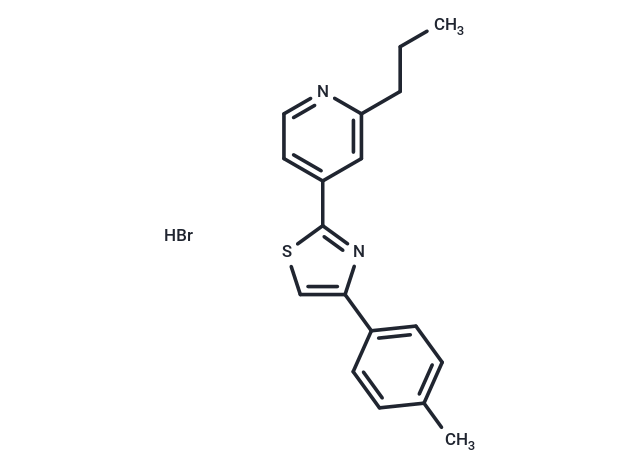Shopping Cart
- Remove All
 Your shopping cart is currently empty
Your shopping cart is currently empty

Fatostatin hydrobromide (Fatostatin A HBr) ia an inhibitor of sterol regulatory element binding protein (SREBP). It impairs the activation of SREBP-1 and SREBP-2.

| Pack Size | Price | Availability | Quantity |
|---|---|---|---|
| 5 mg | $43 | In Stock | |
| 10 mg | $67 | In Stock | |
| 25 mg | $121 | In Stock | |
| 50 mg | $202 | In Stock | |
| 100 mg | $343 | In Stock | |
| 200 mg | $497 | In Stock | |
| 500 mg | $829 | In Stock |
| Description | Fatostatin hydrobromide (Fatostatin A HBr) ia an inhibitor of sterol regulatory element binding protein (SREBP). It impairs the activation of SREBP-1 and SREBP-2. |
| In vitro | Fatostatin inhibits the insulin-induced adipogenesis of 3T3-L1 cells and the serum-independent growth of human androgen-independent prostate cancer (DU145) cells. Fatostatin suppresses cell proliferation and anchorage-independent colony formation in both androgen-responsive LNCaP and androgen-insensitive C4-2B prostate cancer cells. Fatostatin blocks the activation of SREBPs in cells in tissue culture.Fatostatin also reduced in vitro invasion and migration in both cell lines. Further, fatostatin causes G2/M cell cycle arrest and induces apoptosis by increasing caspase-3/7 activity and the cleavages of caspase-3 and PARP. |
| In vivo | Fatostatin significantly inhibits subcutaneous C4-2B tumor growth and markedly decreases serum PSA level compared to the control group. Fatostatin blocks increases in body weight, blood glucose, and hepatic fat accumulation in obese ob/ob mice, even under uncontrolled food intake. |
| Cell Research | Cell lines: CHO-K1 cells. Concentrations: 20 μM. Incubation Time: 20 h. Method: On day 0,CHO-K1 cells are plated out onto a 96-well plate in medium A.On day 2,the cells are transiently cotransfected with pCMV-PLAP-BP2(513–1141),pCMV-SCAP,and pAc-β-gal,using Lipofectamine reagent.After incubation for 5 hr,the cells are washed with PBS and then incubated in medium B,in the absence or presence of fatostatin (20 μM) or sterols (10 μg/mL cholesterol and 1 μg/mL 25-hydroxycholesterol).After 20 hr of incubation,an aliquot of the medium is assayed for secreted alkaline phosphatase activity.The cells in each well are lysed and used for measurement of β-galactosidase activities.The alkaline phosphatase activity is normalized by the activity of β-galactosidase. |
| Animal Research | Animal Models: Obese (ob/ob) mice (C57BL/6J background). Formulation: 10% DMSO in PBS. Dosages: 30 mg/kg. Administration: intraperitoneal injection |
| Alias | Fatostatin HBr |
| Molecular Weight | 375.33 |
| Formula | C18H18N2S·HBr |
| Cas No. | 298197-04-3 |
| Smiles | Br.CCCc1cc(ccn1)-c1nc(cs1)-c1ccc(C)cc1 |
| Relative Density. | no data available |
| Storage | Powder: -20°C for 3 years | In solvent: -80°C for 1 year | Shipping with blue ice/Shipping at ambient temperature. | ||||||||||||||||||||||||||||||||||||||||
| Solubility Information | DMSO: 3.75 mg/mL (10 mM), Sonication is recommended. Ethanol: 58 mg/mL (154.53 mM), Sonication is recommended. H2O: < 1 mg/mL (insoluble or slightly soluble) | ||||||||||||||||||||||||||||||||||||||||
Solution Preparation Table | |||||||||||||||||||||||||||||||||||||||||
DMSO/Ethanol
Ethanol
| |||||||||||||||||||||||||||||||||||||||||

Copyright © 2015-2025 TargetMol Chemicals Inc. All Rights Reserved.